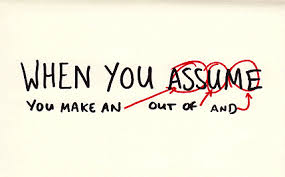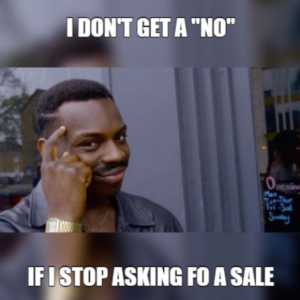

Yet for many small businesses, we do not create a plan for the business culture.

Why?

Most likely not.
Was it?:
Blogs like this can be delivered to your inbox.
Every Thursday.




Every Thursday.

I get contacted by sales people all the time asking me if I would like to attend their events. Oddly and they all seem to use the very same sales pitch. If you receive these calls, then I assume you have heard this sales pitch too:
“Your competitors are attending!”
It is basically going back to the old phrase:
“Everybody’s doing it” and reminds you of:
Now this sales pitch must be very effective because it is repeated, over and over again.
So why does this technique work for sales people?

I would be lying if I said that when sales people said that my competition was attending that I didn’t have the immediate urge to attend as well. I am a very competitive person, I believe that my company should have ALL the business and not share any prospect or revenue. (realistic, I know)
Even part of me wants to attend just to single-handedly make it a worse event for my competition. But then logic kicks in. Asking questions such as; is this profitable? Is this the best way to spend the budget?
When I ask myself these questions, I am quick to talk myself out of attending.
See, if I am going to invest thousands of dollars of my marketing budget and take employees away from their day-to-day activities, I want the ability to grab leads and close them quickly without them knowing about my competition.
Just think about it, the instant your competition is at the show, is the instant you will have to get in a discussion about how you compare to your competitors, this prolongs the sales cycle and not to mention probably significantly lowers the conversion rate (assuming your competition is comparable is some way).
Sometimes if the show is large enough, or has the correct audience.. maybe. But most likely, I am leaning towards “no”.
Emotion from competition plays a huge role in our marketing strategies.
Think what you do the instant you want to optimize your site? You go to your competitor’s website and see their meta description to help you come up with keywords, then implement it to your own. This is common practice, but when you break it down – You are actively looking for keywords that are not easily obtainable.
What do you do when you have copy writing issues? You go to your competitors’ marketing materials and see how they talk about their product and copy it. This strategy completely ruins any product differentiation and tends to hurt you rather than help.
Lastly, you look at your competitors; paid search and go afters similar keywords. Now you get to go head to head and pay more per word! Great way to optimize a budget. (totally kidding here)
I am not saying that you should not look at your competitors at all, but I am saying do not base decisions off of it.
In undergrad (go Drake Bulldogs!), I had a creative advertising professor that said, “not all agency ads are good ads.”
At the time we all dreamed of working for agencies and admired all the work that came our of these creative firms. My professor said this to outline that, just because someone is doing something.. doesn’t mean it is done correctly.
I believe this also applies to your competition. How do you know that the content your competitor produces is worth copying? How do you know the keywords are the best ROI? And how do you know their PPC campaign is even profitable?
The truth is, due to our competitive nature – we make assumptions.

Companies actively choose to go head-to-head without making decisions based on their own data or customer base.
This thought process leads to entire industries to have minimal product differentiation, which then just leads to a battle on price. If you are a very large company with buying power, maybe this is the battle you have always wanted.
Although for the vast majority of companies created, I doubt their mission statements are

Most companies set out to be different, they find a niche or weakness in the industry that allows them to quickly grow.
We all start with the creation of a great SWOT analysis to know how we stand out from everyone else. Those that succeed are the ones that actually stick to their niche; building brand loyalty and creating clear product differentiation.
You can do the same, it just means that you do not allow your competitor’s actions to be your guiding light for your marketing strategy. To truly stand apart from your competition, find out who your ideal customer is, understand their pain point., learn how to talk to them, and continually try to improve their brand experiences.
By using your own factual data, you will see an increase in product differentiation, lower cost per customer, and speed of your sales cycle due to your honed in the approach of your customers’ needs.
It’s your turn to stand out!

Every homeowner has a task that they do not want to do, whether it is electrical, plumbing, or as simple as replacing a light bulb — we all know what they are.
When we think about doing this work ourselves, our brain sends an immediate trigger that looks something like:

For me, I had the gutter from hell. The instant I saw it, I knew I never wanted to touch it.
It was a gutter that had a rotted away fascia that you knew would only come off in bit sized pieces, and a spout in a location that could only be reached from extending your body from a ladder a meter away. This made replacing it come with the bonus of pulling a muscle and having your life flashing before your eyes at the same time!
But yet, as you can tell from the blood stain that still rests on the gutter today, my decision to never do this project changed.
So, what made this change of direction? I started to breakdown my decision process, and realized that my quick decision actually involved two variables:
The gutter had been an eyesore ever since I moved in,so I knew this project was a necessity. Although because this upgrade, unlike a kitchen remodel, adds no value to the house I did not want to pay a lot for it.
So my “No” turned into, “No, not doing it unless unless it ends up costing more than $600.”
After an extremely large quote from a gutter professional. Click here for the full rant on that subject.
I drove over to Home Depot and started my hellish project.
After 5 flesh wounds, 2 days of work, and $300 – I was left with a new gutter and sense of pride.

How does this relate to marketing your business? It doesn’t – I just wanted to let you know that I single-handled installed my own gutter!
Just kidding.
The point I am getting at is that it is very easy to make immediate decisions, especially in a quick moving business. Sadly, these quick decisions commonly lead to saying “no” to projects that fall outside the norm of the company or your preferences.
When decisions are made quickly, they rarely look into all the details that go into them. Things like high cost, large time investment, or increased risk of failure can lead to an immediate denial from any project moving forward.
Although saying no to these outliers may save you from some losses, they also stop companies from being truly innovative.
If a company can move away from the thought process that every decision is either “Yes” or “No” and start thinking more about what would make a NO become a YES – businesses can drive growth, knowledge, and great company moral.
Let me explain:
I am sure you have had a boss or at least a friend that had the attitude, “my way or the highway.” They need to have things done in a very specific manner and tend to not accept things outside of that.
Companies also tend to create this same kind of culture. Some companies are more innovative, some are more prone to take risks, and some tend to have very strict guidelines to how things must be done.
When a company gets to be a certain size, these restrictions are at times needed to keep order, but that should not get in the way of being innovative.
In my professional career, I have seen a lot of ideas that got shot down from social media to new product introductions that held a lot of merit, but were immediately not pursued due to their overpriced budget or not aligning with the company’s mindset.
I have found that these decisions of saying no, can be far more productive if you say yes with restrictions. “Yes, you can try this social media..but with this budget until we see it being beneficial” – “I will say yes to this new product, IF you can show a market need and align it to our brand”
by moving to this mindset, here is what you will see:
Let’s say a your marketing team has suggested 2 very different marketing campaigns that are targeting web traffic through back-links as a strategy, and another that is trying to create thought leadership in the industry. Both will potentially take a lot of time and money to communicate with other websites and create content.
At this time, you may not have a budget that supports that type of expenditure. Therefore you respond, “if we can get both KPIs for the cost of a single campaign, I will say yes.”
Although this is a “No” in many ways, you will start to notice employees enjoy challenges and are capable of generating creative ways to satisfy the requirements.
For example, maybe you reach out to other thought leaders for an interview. You send over questions and promote it on your site. Due to the flattering nature of the article, the company promoted will link to it and share it to their contacts. This way the content was free, thought leadership is gained, and a back-link created.
In my first sales job, I heard the word “no” more than 50 times a day.. some of them even said it in more creative ways that involved 4 letter words.
When you hear so many NOs you tend to stop thinking there will ever be a Yes.
Once you believe that you will never receive a Yes, it makes no sense to even try for it. This leads to people thinking they do not have an power to make a difference, and being unproductive in the workplace.

By giving a Yes with requirements, you are providing transparency into the decision making process. Employees will start to notice patterns around what usually gains approval. They will then create opportunities or ideas that meet these KPIs in a more efficient manner generating more acceptable pitches in fewer time.
Giving a yes with guidelines, forces companies to do more with less. In the process, businesses will stumble upon new efficiencies, strategies, or technologies that allow the business to develop a more scale-able company structure.
What did we just learn about saying no.

